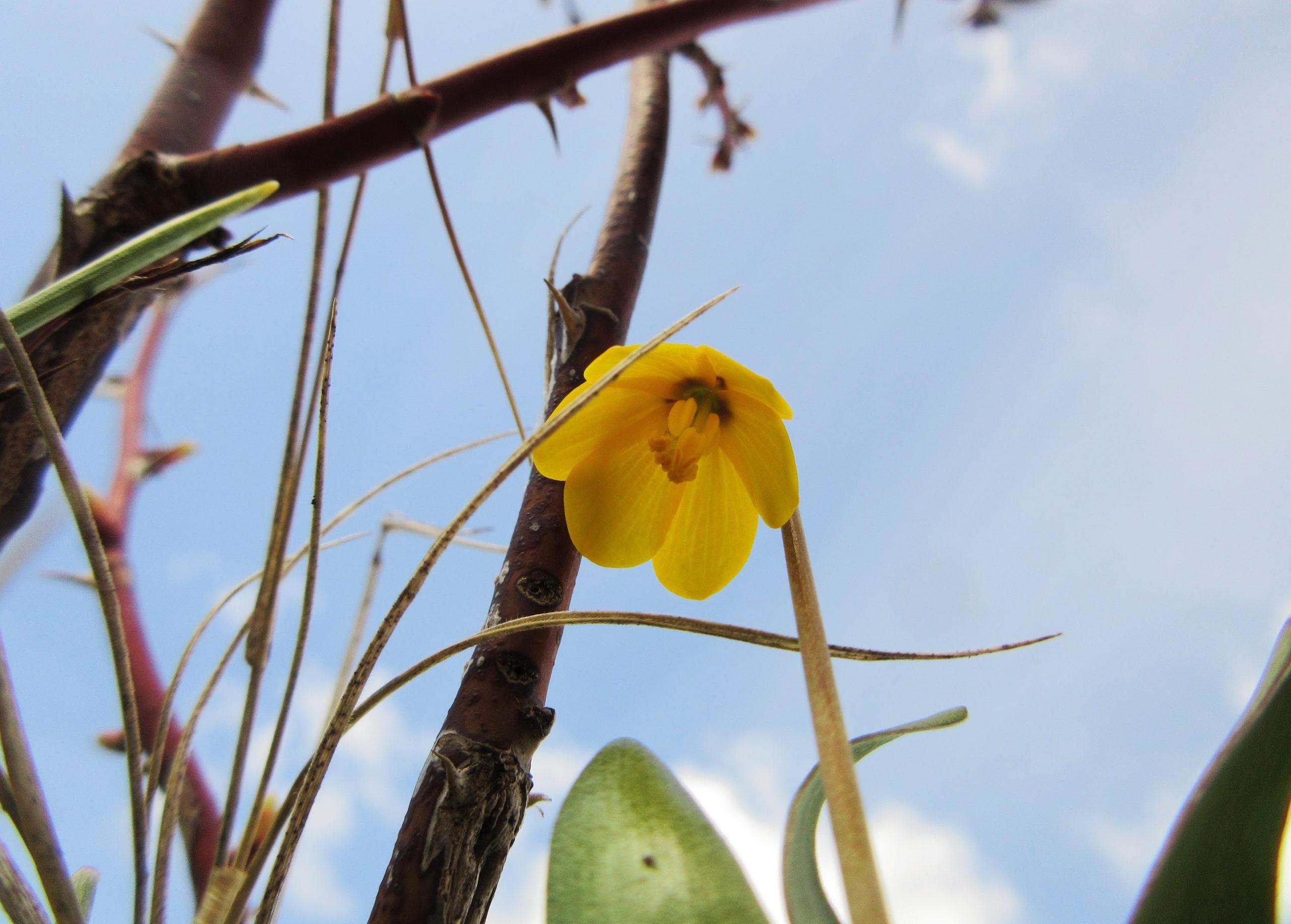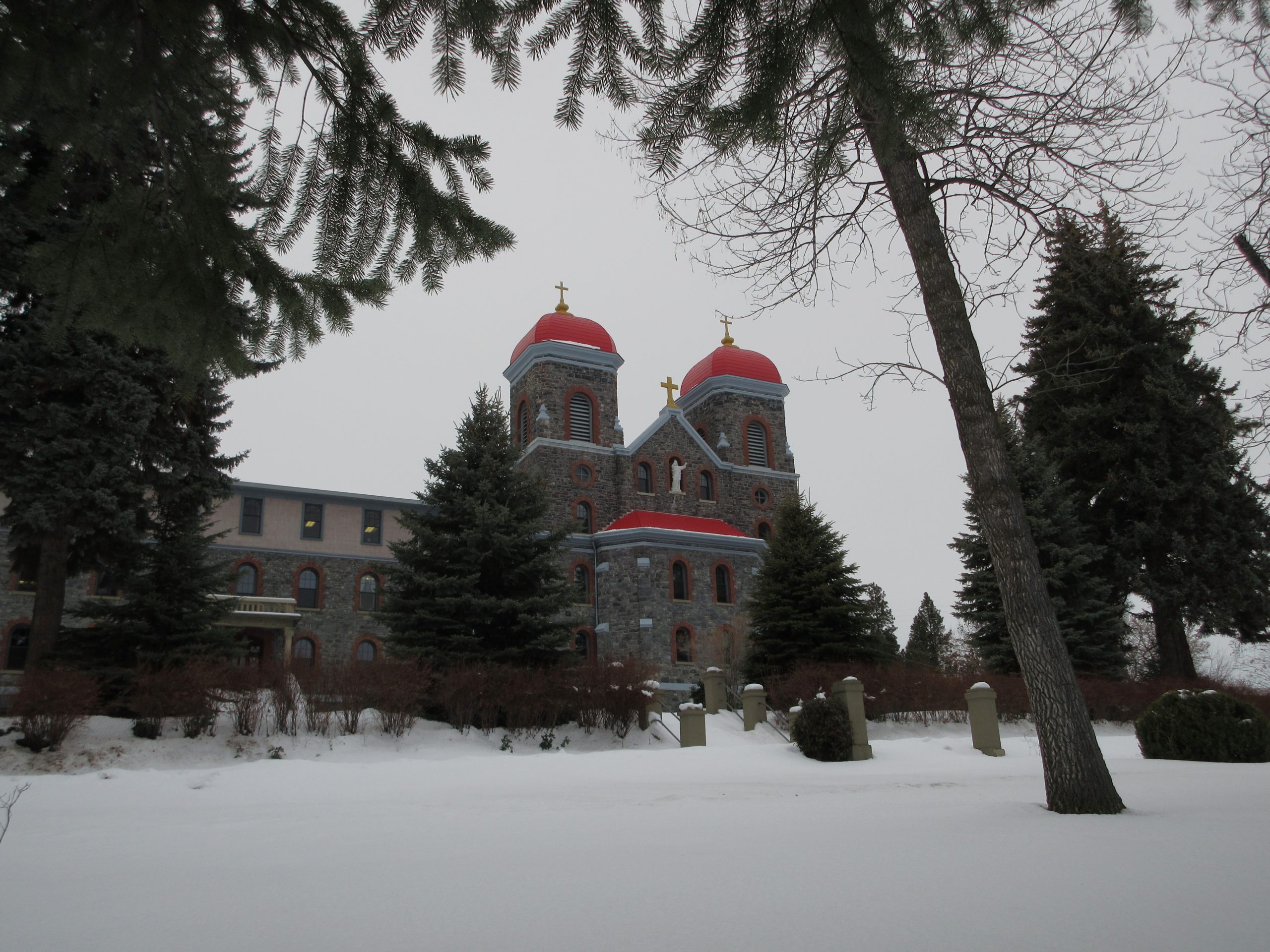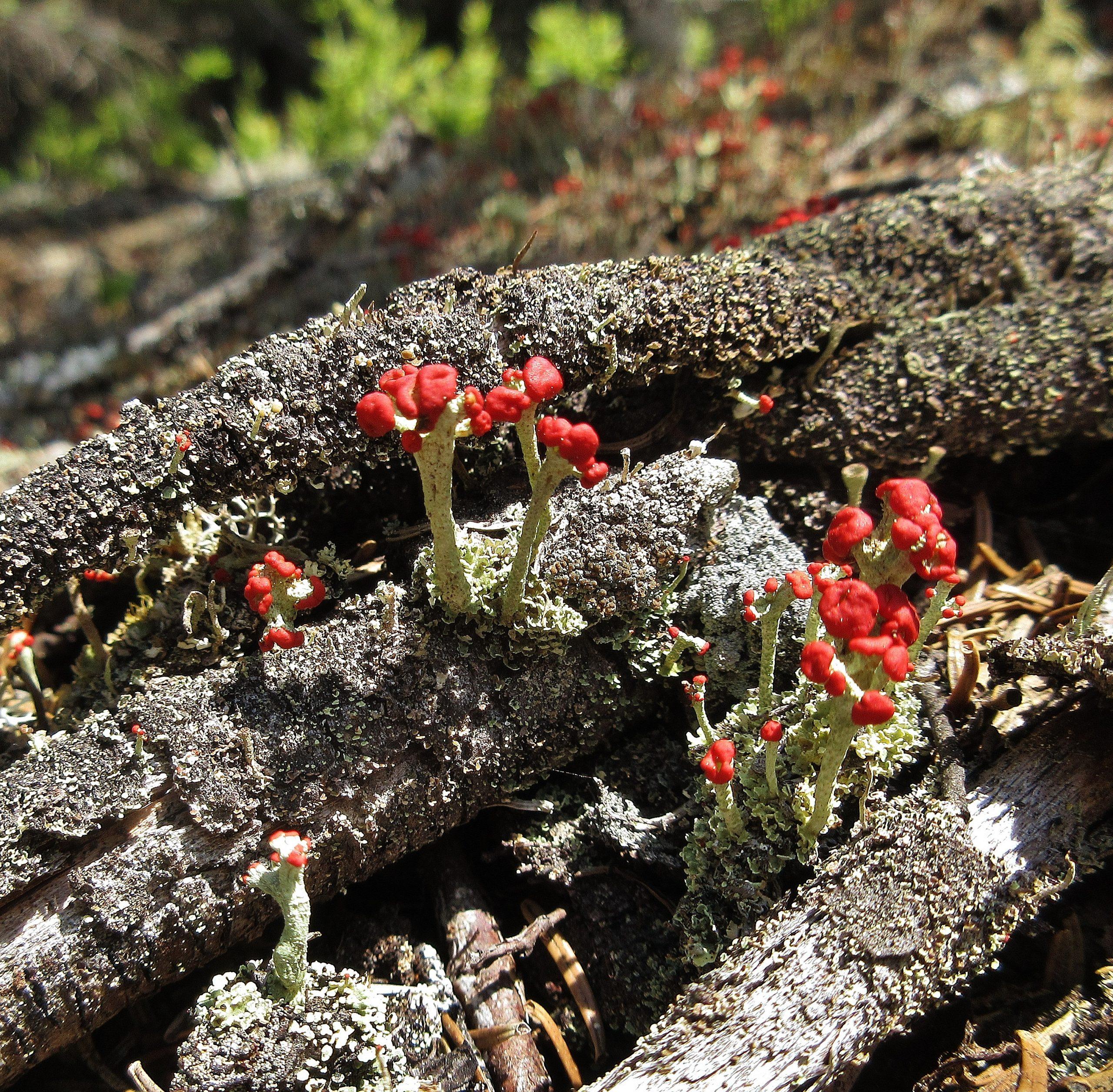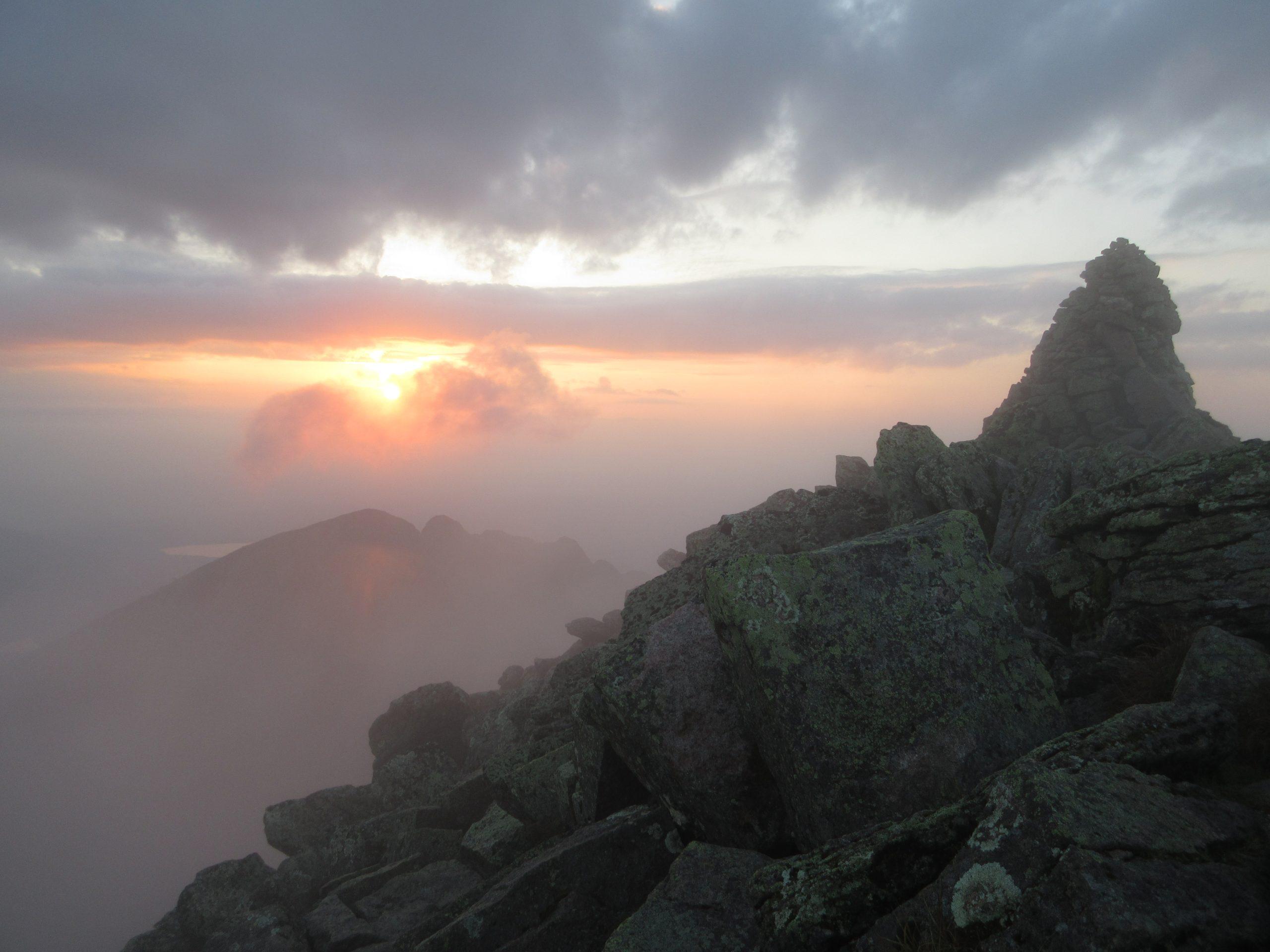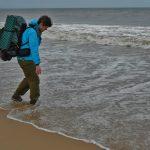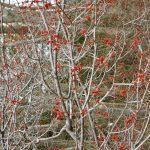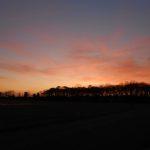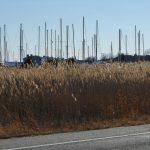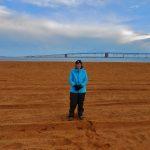Where have the past five and a half months gone? Winter seems to have flown by. Spring has undeniably arrived at my cabin door.
Long-bare tree branches are unfurling small, tender new leaves. They glow in shades of vibrant green and rusty tints that foreshadow their autumn hues. Maine’s growing season is short: fall colors will start to manifest in just four months. Each bright, warm day between now and then will be a gift worthy of savoring.
On my forest floor, leaves of wild lily-of-the-valley have erupted from brown leaf litter to form a green carpet. Goldthread’s little white flowers blossom just above; the name refers to the color of the plant’s slender underground stem.

Just two days ago, I spotted my first painted trillium. There will surely be more to come. The “tri” indicates the three-parted nature of the plant: three petals, three sepals, three leaves. Some people consider it to be a symbol of the Holy Trinity.
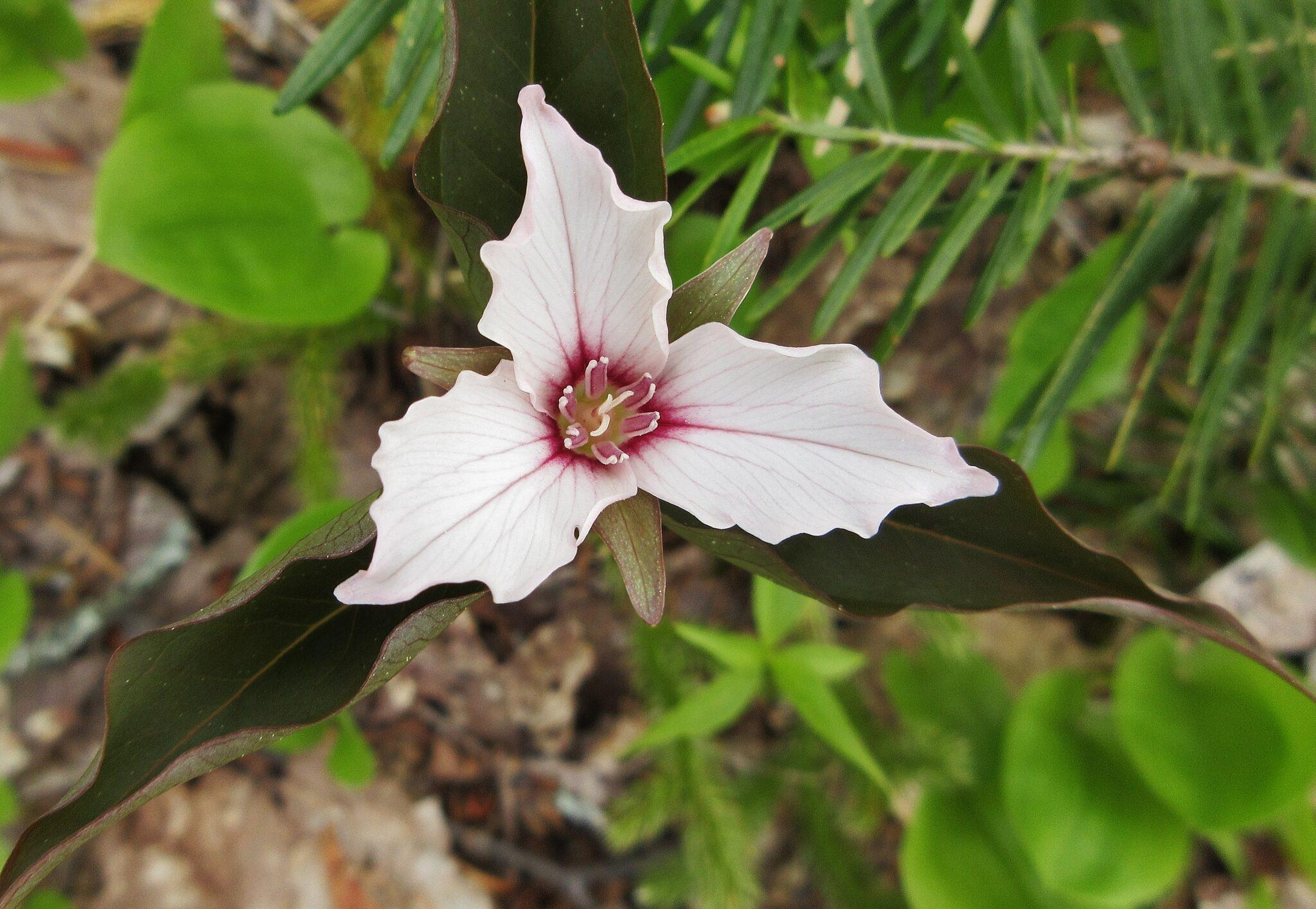
Along my shore, shadbush trees are blooming. They flower at the same time of year that shad used to leave the sea and swim up rivers to spawn. In modern times, their journey has been blocked by dams. I’m grateful that efforts such as the Penobscot River Restoration Project are enabling these fish to return to their ancient spawning grounds.

I’m always looking for ways to access as-yet-unexplored pockets of my “big backyard.” In celebration of the new season, I’ve invested in a new watercraft: a packraft. It’s like an elongated innertube with a waterproof floor. According to the manufacturer, it “weighs just 5.2 [pounds] and packs down to the size of a roll of paper towels.” I’ll be able to carry it on my back on hikes and use it to explore countless little ponds hidden deep in the woods or nestled into mountains.
For my maiden voyage, I inflated my raft on the shore of the Roach River just below the outlet of Second Roach Pond. I put it in the water and let the current carry me toward the North Inlet of First Roach Pond. Recent rain meant the water was flowing at a decent level, but there were still some “bony” spots where I bumped over rocks.
As I neared the North Inlet, the river spilled over its banks onto what had once been drier ground, and I heard water roaring ahead. I guessed that beavers had been hard at work building a dam downstream. I took advantage of the flooding to paddle closer to a tree that raised its branches toward the sky in a graceful, vase-shaped configuration. I was delighted when it proved to be an elm. Most American elms fell victim long ago to Dutch elm disease. But in the Maine Woods, I’ve occasionally seen them along rivers. Growing in remote spots, they’re protected from infection by means of social distancing from fellow members of their species.
After leaving the elm behind, I soon reached the beaver dam. It was impressive: river-wide and about four feet high. I scrambled around it, raft in tow, and continued on to the North Inlet.
To get home, I needed to paddle around the peninsula where my cabin sits. Along the way, I passed the tall pine with the eagles’ nest I’ve been monitoring. I felt a surge of joy when I saw an eagle perched on a branch just above the nest. The date was May 7, four weeks since I first spotted an eagle there. Does this ongoing activity at the nest mean there are eggs incubating within? I’ll keep checking!

My packraft excursion brought to mind one of my earliest forays into outdoor adventure. I was about ten years old and living in the Maryland suburbs of Washington, D.C. There wasn’t any way I could access really wild territory on my own, but whenever I got the chance, I headed out with a friend to explore a little creek that ran through nearby woods. The stream was so small it did not even have a name, but I loved wandering along its banks, wondering what lay around the next bend. I fantasized about getting a small boat that would allow me to explore it more fully. Not long after, I entered a highly competitive prep school, and my time for carefree play dwindled. But now, half a century later, I have finally realized my youthful dream. As a wise outdoor mentor once told me, “it’s never too late to have a happy childhood.”
Next week, I’ll return to my seasonal job with the Appalachian Trail Conservancy. This will be my fifth year managing the Monson Appalachian Trail Visitor Center. We’ll be open to the public seven days a week, 8-11 AM and 1-5 PM, from June 2 through October 11. We help long-distance and day hikers plan treks on the A.T. and many other trails in the Hundred Mile Wilderness and Moosehead Lake regions. We offer information about other outdoor activities, such as canoeing and moose watching, as well. If you’re passing through Monson, please stop by! I’d love to help you plan your own adventures.
During my workweek, I’ll be staying in a rented room in Monson. I’ll be off Mondays and Tuesdays and will spend at least some of those days back home at my cabin. I’ll continue to post North Woods news updates as time allows…
Answers to your questions about my cabin life:
I’ve been collecting questions that you, my readers, have been sending me over the past few months. I’m always grateful for your interest! I’ve answered some specific questions in personal replies. Other questions touch on themes that come up repeatedly, and I answer some of those below.
What kind of meals do you cook yourself? Do you cook on your woodstove?
I have a propane cookstove with four burners and an oven. It’s basically a small, no-frills version of a gas range that would typically be found in an on-the-grid home.
Because I need to pump and haul water for doing dishes, I try to avoid recipes that will result in a lot of dirty utensils, bowls, pots or pans. I favor meals I can cook in my nonstick skillet, which I can simply wipe clean with a damp paper towel. I’ll often prepare eggs, either fried, or scrambled with add-ins including cheese, chives, and sweet pepper (when I have it). A favorite skillet meal is chicken with apples, onions and cheese: I heat a little olive oil, sauté sliced apples and onions, add baked chicken, top it all off with cheddar, then put the combination into the oven to melt the cheese. Or I sauté sliced potatoes and onions, then add cut-up pieces of ham steak.
I bake another easy clean-up favorite in a foil packet: a pork chop sprinkled with salt and pepper, covered in sliced apples, drizzled with both apple and maple syrups and dusted with cinnamon. This is especially good with a side of baked acorn squash mashed with butter and maple syrup.
When I’m staying in my cabin for weeks without resupply, if I want fresh bread, it’s up to me to bake it. I use a standard recipe, but do everything with just one bowl (for mixing, kneading, and first rising) and one pan (for second rising and baking). The resulting bread, slathered with butter, smells and tastes delicious to me, though its appeal may be due to the hunger I generate through physical work in cold temperatures.

I love baked desserts – cakes, cookies, pies, cobblers – but because they generally require a lot of utensils as well as some bowls and pans, I make them only occasionally, as special treats. That’s just as well. I don’t need to eat them every day.
I bought an inexpensive hand-crank mixer last fall. I’ve been pleased by how easy it is to use. As for ingredients, I left a stash of local cranberries, raspberries, and blackberries in a friend’s freezer, so that I could retrieve a few packets for cakes and cobblers on my supply trips to town. And I recently discovered a new favorite recipe: an easy-to-make Maine Molasses Cake, laden with raisins, a staple at old-time lumber camps: https://www.meseniors.com/2021/01/25/maine-molasses-cake/. The recipe doesn’t specify a baking temperature, but I’ve found that 350 Fahrenheit works well for me.
What do you use for refrigeration?
My “refrigerator” is a pair of coolers on my porch. I can buy ice for the coolers in town when I get my groceries. This spring, I’ve mined lingering patches of snow to use in place of store-bought ice; I gathered the last little bit from a sheltered spot near my shore on May 7. When the air temperature is in refrigerator range (33-40 degrees Fahrenheit), ice isn’t needed to keep the contents safely cold, but the coolers serve to protect my food from roaming critters. When the air drops below freezing, the coolers actually serve to insulate the contents and keep things like eggs, milk, and salad greens from freezing. Of course, when the temperature plummets, the cooler contents freeze anyway. If I’m fortunate enough to spend another winter at my cabin, I’ll experiment with burying a cooler in snow to see if the inside will stay warm enough that eggs don’t crack and greens don’t wilt.
If your pump malfunctioned, couldn’t you melt snow to get water?
If my pump stopped functioning, I could either melt snow or chop a hole through the ice of First Roach Pond with my axe. I would need to boil the pond water before drinking it, because local beaver carry giardia, an intestinal parasite that infects humans. Unless snow is freshly fallen, it tends to have tree or other plant debris in it, and there might even be embedded animal droppings, so I’d want to boil the snow as well.
The pump is an easier, cleaner option. My pump doesn’t freeze because the water drains below the frost line when I stop pumping, and I’ve had no problems with it to date. But any tool can break down, so it’s good to have backup options.
Is the toilet in your outhouse over a tank, or do you have a composting toilet?
The toilet in my outhouse is above a sealed tank, meaning that someone will eventually need to come to empty it. I don’t anticipate that it will reach capacity anytime soon, with just me and the occasional visitor using it (I’m not that full of you-know-what). If I had it to do over again, I would consider a composting toilet, but when the outhouse was built in 2008, this wasn’t an option of which I was fully aware.
Could you harvest wood from the surrounding forest in the summer to use as firewood in the winter?
I have 12 acres of land and can cut trees from it if I wish, though there are some environmental and scenic restrictions I would need to follow. My forest is regenerating after being cut in the past. Most of my trees are young, and many are too small to serve as firewood.
A large percentage of my trees are spruce or fir. According to at least some reports, softwoods like spruce and fir are not ideal for burning in woodstoves because they generate a lot of creosote, which can cause chimney fires.
I do have quite a few red maples that have been coppiced, meaning they were cut close to the ground, and sprouts from the original trunk grew upward in a circle around the stump. These sprouts, once they reach a few inches in diameter, make excellent firewood. If I lived here full-time this summer, I could saw the sprouts into appropriate lengths for my woodstove and stack them in my portable shed to dry for winter firewood. However, I’ll be working for the Appalachian Trail Conservancy, and with other chores that need to get done, I wouldn’t have time for this project on the two days a week I’ll be off.
Is there anything you don’t have in your cabin that you wish you had installed when you built it?
I wish I had a bigger porch. My porch is just 5 X 14 feet. Between my coolers, my generator and gas cans, my metal ash storage container, and various tools, there’s not enough room to put out a comfortable chair to relax in screened seclusion from blackflies and mosquitoes. When my mother and I had the cabin built in 2008, I wasn’t thinking about all the appurtenances that full-time residency here would require.
There’s one more thing I sometimes wish I could change, though it’s beyond my control to do so. My pump is nearly three hundred feet from my cabin. The ground nearer to my cabin was too soft to support the heavy equipment needed to drill my well. On one level, I would prefer to have the pump closer, but on another, I appreciate the exercise the extra distance gives me.
What pastimes do you have in the cabin? Do you spend all of your time doing chores and writing? Do you do crafts or art projects? Do you knit? Do you listen to music…if so what music and what device? Do you read…if so, what books are you reading?
I don’t spend all my time doing chores and writing. I spend some of my time roaming the local woods and shores, studying animal tracks, birding, botanizing, or simply enjoying the views, especially sunsets. When I get back inside, I may want to pull out my field guides or go online for better understanding of the day’s discoveries. I also generally have photos to upload to my computer, and I may put some time into editing my favorites. I invest a few minutes each day in my gratitude journal, jotting down a few things for which I’m especially thankful. These may include animals or birds I’ve encountered, beautiful sunsets or snowscapes, good meals, virtual interactions with friends, or simply the coziness of my snug cabin.
With regard to arts and crafts, photography is my only serious venture into that realm. I learned basic knitting stitches as a child. But, as I recall, when I tried to make myself a scarf, I lost patience and turned it into a bedspread for my dollhouse. Thus ended my career in knitting.
As for listening to music at my cabin, every additional electronic device, or extra use of my computer, eats into my limited gasoline supply for my generator. So the most I’ve done is listen to an occasional YouTube recording.
However, I love music. I sang in two local choral groups prior to the pandemic: the Greenville Union Church Chancel Choir and the Moosehead Community Chorus, which offered annual Christmas concerts in our region for several decades. Of course, the pandemic put a stop to in-person group singing, but I do a little singing on my own at my cabin. A friend lent me a battery-powered keyboard, which I store under my bunk bed, and I use it to play melodies or give myself pitches. Shortly before Christmas, I sang the old hymn “Of the Father’s Love Begotten” as a solo in a Union Church Zoom service, participating remotely via my satellite Internet. And some of you reading this have probably heard my rendition of “Morning Has Broken” on my shore on Easter morning (https://www.youtube.com/watch?v=_HcwkCGGnUk).
I also like to read books. Some of my friends have written books, and it’s always a pleasure to read them. A comrade in environmental activism, Sandra Neily, recently published her second Maine Woods eco-mystery, Deadly Turn (https://www.amazon.com/Deadly-Turn-Mystery-Sandra-Neily/dp/1950381528). It made great fireside reading on winter evenings. I enjoyed her first mystery, Deadly Trespass, as well (https://www.amazon.com/Deadly-Trespass-Mystery-Maine-1/dp/8494614959). Sandy’s books are multi-layered, educating readers about the many threats to Maine’s forests, waters, and wildlife, even as they entertain.
I’m currently reading Whole-Earth Ethics for Holy Ground, a scholarly book about nature-centered spirituality in the Christian tradition, by Reverend Stephen Hastings, a leader of the Earth Care and Spirituality Resource Team of the Maine Conference of the United Church of Christ (https://www.barnesandnoble.com/w/whole-earth-ethics-for-holy-ground-stephen-l-hastings/1124252096). Steve presents an understanding of nature as a sacred web of which we humans are a part, and through which we may experience the divine.
I currently subscribe to just one magazine: Family Life, written by and for the Amish. I’ve long been interested in the Amish as members of off-the-grid intentional communities. I’ve read nonfiction works about Amish culture and memoirs of people who have lived with or were born into Amish families; I’ve visited Amish tourist attractions in Pennsylvania and shopped at Amish businesses in Maine. But the books and articles were written by people outside Amish society, the tourist attractions were run by and geared toward outsiders, and when I go into an Amish business, the staff know I’m not part of their world. Through Family Life, I can listen in as the Amish talk to each other, about subjects as diverse as birdwatching, gender relations, and the inevitable creep of technology into their sheltered lives, despite strenuous efforts to keep it at bay.
Do you ice fish on First Roach Pond in the winter?
Ice fishing is very popular in Maine, but First Roach Pond is closed to ice fishing in order to protect the salmon population. The pond was opened for winter fishing on a trial basis a few years back, with biologists monitoring the numbers and species of fish that anglers caught. Ultimately, they decided not to open the pond for ice fishing over the longer term. Though I would enjoy harvesting salmon, brook trout, and togue to eat over the winter, I don’t mind the ban, because it protects my solitude. When ice fishing was allowed, the pond had more winter visitors.
Your remote location would present some significant hurdles if you injured yourself – for instance, if you experienced a fracture or severe burn. Would you describe your contingency plans? As a medical doctor, do you have an advanced medical kit? Do you have a personal locator beacon? Do you check in with someone every day or three days?
I have two medical kits: one that I leave in my cabin, and a second, smaller one that I carry in my daypack when I’m hiking or paddling away from the cabin.
In my daypack, I carry the following, in addition to the provisions for fire, shelter and water I discussed in an earlier post (https://www.wendyweiger.com/a-hike-up-shaw-mountain-and-survival-on-the-trail/): a SAM splint (https://www.sammedical.com/products/sam-splint), which easily molds to the shape of an injured limb; triangle bandages and safety pins; an ACE elastic bandage; a roll of gauze and a roll of cloth tape; band-aids of various sizes, including extra-large; blister band-aids and moleskin; tweezers; a compact towel; alcohol pads for cleaning wounds; and nitrile gloves. With these, I could splint a fractured bone, using wood or household implements as supplemental splinting material if needed; make a sling; apply a compression wrap to a sprained joint; clean debris from and bandage an open wound; or protect blistered skin from further chafing.
The kit in my cabin also has non-stick pads for dressing wounds; antibiotic ointment and hydrocortisone cream; artificial tears (to help wash out dust, grit, or other irritants from eyes); a thermometer; naproxen (a non-steroidal anti-inflammatory medication for both pain relief and fever reduction); diphenhydramine (an antihistamine sold under the brand name of Benadryl); aspirin (for heart attack, though I’m at very low risk); a senna laxative with stool softener; decongestant nasal spray and tablets; Q-tips; and eyeglass repair tools.
In my daypack, I carry a GPS tracking device that I can use to send emergency text messages to friends or to summon first responders in case of a mishap on the trail. I could use this at my cabin as well, should my Internet fail when I urgently need help. I confess that this was a recent (mid-February) addition to my pack. In retrospect, I should have acquired one sooner. And I need to get a better sense of how often the battery needs recharging when the device is turned off. When I checked it as I was writing this paragraph, I discovered that the battery was depleted.
When I’m planning a hike or paddle that will take me beyond the peninsula where my cabin is located, I let an Achor Earth Ways board member know where I’m going, and set a check-in deadline that should allow me ample time to return to my cabin. If I fail to check in by the specified time, she will alert the county sheriff’s office. I followed this protocol, for example, when I hiked to the summit of Shaw Mountain (https://www.wendyweiger.com/a-hike-up-shaw-mountain-and-survival-on-the-trail/), and when I took my packraft on its maiden voyage.
Even though Greenville (the nearest town) is quiet, relatively speaking, doesn’t it seem, for lack of a better word, LOUD to your ears after the solitude of the woods? Or do you, at some point, crave to hear a voice or vehicle noise?
I find the “crowds” in Greenville – the number of people I encounter at the grocery store, for example – a bit overwhelming after weeks of solitude. Though I greatly enjoy catching up with friends, multiple in-person conversations, after a long period of extreme social distancing, can be tiring.
I engage in some limited interactions with friends and colleagues even when I’m alone in my cabin. I attend Zoom services offered by Union Church in Greenville on Sunday mornings, and I speak with an Achor Earth Ways board member via Facebook Messenger every week or two. I also participate occasionally in other Zoom meetings or Messenger chats related to my work. These interactions may not seem like much by the standards of the mainstream world, but they’ve been enough to satisfy my desire for human connection.
My cabin is not entirely free of mechanical noise, though I wish it were. My generator is small and fairly quiet compared to other models, but it’s certainly not silent. I typically run it 3-4 hours per day to charge my laptop and power my satellite dish.
And for those of you who have expressed interest in my backstory: A new podcast
Here’s a link to a Mainely Matters podcast interview recorded May 10, in which I talk about my life’s journey and how it led me to my cabin in the woods: https://podcasts.apple.com/us/podcast/from-harvard-university-to-living-off-grid-in-maine/id1545972565?i=1000521626649.
Or, if you prefer, here’s a 2019 article I wrote for The Covey Club, a resource for women at midlife who want to continue learning, growing, and developing more authentic lives: https://www.coveyclub.com/blog_posts/found-self-healing-wholeness-nature/.
My book Living Every Season: A Mindful Year in the Maine Woods is available for online ordering! Take a look: https://www.wendyweiger.com/photo-book/. It’s also for sale at several locations in Greenville, Maine: Northwoods Outfitters, the Corner Shop, Indian Hill Trading Post, and the Moosehead Historical Society. And in Monson, you’ll find it at the General Store. (Before making a trip, you may want to call ahead to be sure the shop where you’re headed hasn’t sold out.)


